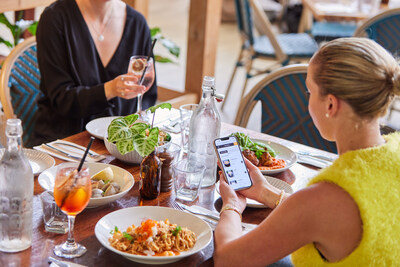Americans, Planning on Dining out More, Turn to Savvy Money-Saving Strategies: Doggy Bags, Happy Hours and Value Meals Surge in Popularity
A recent survey by Lightspeed Commerce reveals that 81% of Americans are dining out at least once a month, with 39% dining out weekly. Consumers are adopting money-saving strategies, such as using doggy bags (45%), opting for value meals (39%), and taking advantage of happy hour deals (36%).
Despite inflation affecting tipping habits, 58% feel pressured to tip more than they'd like, while 44% say inflation impacts their tipping ability. Moreover, 89% prefer physical menus over QR codes, with older demographics showing stronger resistance to digital menus.
Lightspeed surveyed over 7,500 dining consumers worldwide, including 1,500 U.S. respondents. The survey aims to understand evolving dining trends amid rising costs. Restaurants are encouraged to adapt to these trends to maintain customer satisfaction and repeat visits.
- 51% of respondents will either continue to dine out at the same rate or increase dining out in the next six months.
- Consumers are finding creative ways to save money, which may lead to increased dining frequency despite rising costs.
- Doggy bag usage (45%) indicates that customers are keen on maximizing value, which can boost customer satisfaction.
- 69% of diners report higher meal prices.
- 39% observe 'shrinkflation' in their favorite dishes.
- 58% feel pressured to tip more than they prefer due to digital auto-tipping prompts.
- 44% state that inflation has affected their ability to tip.
- 89% of respondents prefer physical menus, indicating resistance to QR code menus.
81% of Americans are dining out once a month or more, with39% dining out once a week or more.- Money-saving hacks include grabbing a doggy bag (
45% ), opting for value meals (39% ), and taking advantage of happy hour deals (36% ). - Consumers are reaching the tipping point with
58% feeling the pressure to tip, while44% saying inflation has affected their ability to do so. - QR menu codes face strong resistance: approximately nine in ten (
89% ) prefer physical menus,34% 'hate' QR versions.
Lightspeed surveyed more than 7,500 dining consumers globally, with 1,500 respondents in the
With
Doggy bags are back in vogue! Nearly half (
"Value is certainly top of mind for restaurant diners at the moment," said Dax Dasilva, CEO and Founder of Lightspeed. "Restaurateurs need to adapt to an environment of cost-savings, but also perceived value. Customers don't want to sacrifice the experience of dining out, they still want to feel like they are treating themselves. Keeping this in mind encourages repeat visits, and a better overall customer experience."
Tipping continues to be a hot topic in the quest to save money when dining out. A whopping
Inflation has affected the amount diners are willing to tip, according to
Interestingly, for scenarios outside of the normal tipping etiquette, survey respondents were overwhelmingly supportive of tipping delivery drivers (
The backlash against QR code menus is palpable. While
The disdain for QR codes is more pronounced among the older generation, with
"Technology on its own, does not necessarily provide a better customer experience," said Dasilva. "Restaurants should think holistically about how best to integrate customer preference and technological innovation to create a unique dining experience. The use of QR codes is not inherently negative. They can be extremely useful in the case of at table payments, or quick ordering; it's more about understanding the use cases that work than applying a catch-all solution. By staying adaptable and responsive to changing consumer preferences, restaurants can not only survive but also thrive in the current landscape."
To learn more about lightspeed, visit www.lightspeedhq.com.
Lightspeed initiated a consumer survey throughout May 2024 using third party survey vendor Medallia. Over 7,500 responses were collected globally, distributed amongst the following countries:
Powering the businesses that are the backbone of the global economy, Lightspeed's one-stop commerce platform helps merchants innovate to simplify, scale, and provide exceptional omnichannel customer experiences. Our cloud commerce solution transforms and unifies online and physical operations, multichannel sales, expansion to new locations, global payments, financial solutions, and connection to supplier networks.
Founded in
For more information, see www.lightspeedhq.com.
Follow us on social media: LinkedIn, Facebook, Instagram, YouTube, and Twitter.
This news release may include forward-looking information and forward-looking statements within the meaning of applicable securities laws ("forward-looking statements"). Forward-looking statements are statements that are predictive in nature, depend upon or refer to future events or conditions and are identified by words such as "will", "expects", "anticipates", "intends", "plans", "believes", "estimates" or similar expressions concerning matters that are not historical facts. Such statements are based on current expectations of Lightspeed's management and inherently involve numerous risks and uncertainties, known and unknown, including economic factors. A number of risks, uncertainties and other factors may cause actual results to differ materially from the forward-looking statements contained in this news release, including, among other factors, those risk factors identified in our most recent Management's Discussion and Analysis of Financial Condition and Results of Operations, under "Risk Factors" in our most recent Annual Information Form, and in our other filings with the Canadian securities regulatory authorities and the
![]() View original content to download multimedia:https://www.prnewswire.com/news-releases/americans-planning-on-dining-out-more-turn-to-savvy-money-saving-strategies-doggy-bags-happy-hours-and-value-meals-surge-in-popularity-302180758.html
View original content to download multimedia:https://www.prnewswire.com/news-releases/americans-planning-on-dining-out-more-turn-to-savvy-money-saving-strategies-doggy-bags-happy-hours-and-value-meals-surge-in-popularity-302180758.html
SOURCE Lightspeed Commerce Inc.









